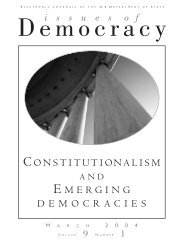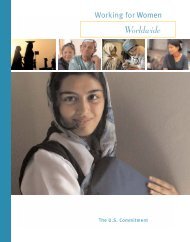Terrorism: Threat Assessment, Countermeasures and Policy
Terrorism: Threat Assessment, Countermeasures and Policy
Terrorism: Threat Assessment, Countermeasures and Policy
You also want an ePaper? Increase the reach of your titles
YUMPU automatically turns print PDFs into web optimized ePapers that Google loves.
example, with resolutions (beginning with Resolution<br />
1267 in 1999) pertaining to the Taliban’s support to<br />
terrorism based in Afghanistan. Multilateral diplomacy<br />
— including resolutions of the U.N. General Assembly<br />
<strong>and</strong> a dozen international conventions on terrorism —<br />
also strengthens an international norm against<br />
terrorism. Some of those conventions, such as ones<br />
dealing with hijacking of aircraft, also provide a basis<br />
for practical cooperation on matters where national<br />
jurisdictions may overlap.<br />
The limitations of diplomacy as a counterterrorist tool<br />
are obvious. Terrorists do not change their behavior in<br />
direct response to a treaty or U.N. resolution. But<br />
diplomacy supports all of the other tools, whether by<br />
broadening the moral force behind them or providing<br />
an international legal framework for their use.<br />
CRIMINAL LAW<br />
level of commitment <strong>and</strong> desperation. High-level<br />
terrorist leaders — who typically stay farther removed<br />
from the scene of the crime <strong>and</strong> are more difficult to<br />
catch — may care little about whether the underlings<br />
are caught.<br />
Prosecuting a terrorist also poses the practical difficulty<br />
of assembling sufficient legally admissible evidence to<br />
convict him. At least in U.S. courts, that is a higher<br />
st<strong>and</strong>ard than acquiring enough information to be<br />
fairly sure, from an intelligence or policy perspective,<br />
that someone is a terrorist. Direct evidence of the<br />
decisions or orders issued by terrorist leaders is<br />
particularly hard to come by. The physically dispersed<br />
planning <strong>and</strong> decision making of international terrorist<br />
groups means many of the actions leading to a terrorist<br />
attack were taken outside the country where the attack<br />
occurs <strong>and</strong> outside the jurisdiction of the lead<br />
investigators.<br />
The prosecution of individual terrorists in criminal<br />
courts has been one of the most heavily relied upon<br />
counterterrorist tools. The United States has placed<br />
particular emphasis on it, with the bringing of terrorists<br />
to justice for their crimes being a longst<strong>and</strong>ing tenet of<br />
U.S. counterterrorist policy. Non-U.S. courts have also<br />
played significant roles. A Scottish court sitting in the<br />
Netherl<strong>and</strong>s was used to try two suspects accused of<br />
bombing Pan Am flight 103 in 1988.<br />
Use of the criminal justice system can help reduce<br />
terrorism in several ways. Imprisoning a terrorist for<br />
life (or executing him) obviously prevents him from<br />
conducting any more attacks. The prospect of being<br />
caught <strong>and</strong> punished may deter other terrorists from<br />
attacking in the first place. Even if not deterred, the<br />
movements of terrorists still at large can be impeded by<br />
the knowledge that they are wanted men. The drama<br />
<strong>and</strong> publicity of a criminal trial may also help to sustain<br />
public support for counterterrorism, demonstrate a<br />
government’s resolve to go after terrorists, <strong>and</strong><br />
encourage other governments to do<br />
the same.<br />
A limitation of applying the criminal justice system to<br />
terrorism is that the prospect of being caught <strong>and</strong><br />
punished does not deter some terrorists. That prospect<br />
is obviously irrelevant to suicide bombers, <strong>and</strong> perhaps<br />
also to other low-level operatives who feel a comparable<br />
11<br />
The need for international cooperation in applying<br />
criminal law to terrorists is obvious. It involves not<br />
only acquisition of evidence for use in court but also<br />
the extradition or rendition of fugitives to st<strong>and</strong> trial in<br />
the country where they are charged.<br />
FINANCIAL CONTROLS<br />
The funding that evidently made it possible for the<br />
perpetrators of the attacks in September to train <strong>and</strong><br />
travel as they prepared for their operation has<br />
highlighted efforts to interdict terrorist money. The<br />
United States uses two types of financial controls to<br />
combat terrorism: the freezing of assets belonging to<br />
individual terrorists, terrorist groups, <strong>and</strong> state<br />
sponsors; <strong>and</strong> the prohibition of material support to<br />
terrorists. Money is also the subject of the most recent<br />
multilateral treaty on terrorism: the Convention on the<br />
Suppression of the Financing of <strong>Terrorism</strong>, which was<br />
opened for signature in January 2000.<br />
Cutting off terrorists’ funding faces two major<br />
challenges. One is that — notwithst<strong>and</strong>ing the<br />
importance of financial backing to the September<br />
hijackers — most terrorism does not require large-scale<br />
financing. Less money is involved than in illegal<br />
narcotics, arms trafficking, <strong>and</strong> some other<br />
transnational criminal activities. The other challenge is<br />
that the flow of terrorist money is extremely difficult to












